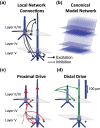Neural Mechanisms Underlying Human Auditory Evoked Responses Revealed By Human Neocortical Neurosolver
- PMID: 33876329
- PMCID: PMC8813713
- DOI: 10.1007/s10548-021-00838-0
Neural Mechanisms Underlying Human Auditory Evoked Responses Revealed By Human Neocortical Neurosolver
Abstract
Auditory evoked fields (AEFs) are commonly studied, yet their underlying neural mechanisms remain poorly understood. Here, we used the biophysical modelling software Human Neocortical Neurosolver (HNN) whose foundation is a canonical neocortical circuit model to interpret the cell and network mechanisms contributing to macroscale AEFs elicited by a simple tone, measured with magnetoencephalography. We found that AEFs can be reproduced by activating the neocortical circuit through a layer specific sequence of feedforward and feedback excitatory synaptic drives, similar to prior simulation of somatosensory evoked responses, supporting the notion that basic structures and activation patterns are preserved across sensory regions. We also applied the modeling framework to develop and test predictions on neural mechanisms underlying AEF differences in the left and right hemispheres, as well as in hemispheres contralateral and ipsilateral to the presentation of the auditory stimulus. We found that increasing the strength of the excitatory synaptic cortical feedback inputs to supragranular layers simulates the commonly observed right hemisphere dominance, while decreasing the input latencies and simultaneously increasing the number of cells contributing to the signal accounted for the contralateral dominance. These results provide a direct link between human data and prior animal studies and lay the foundation for future translational research examining the mechanisms underlying alteration in this fundamental biomarker of auditory processing in healthy cognition and neuropathology.
Keywords: AEF; Auditory processing; Biophysical model; HNN; MEG.
© 2021. The Author(s).
Conflict of interest statement
The authors declare that no competing interests exist.
Figures






Similar articles
-
Neuronal Modeling of Cross-Sensory Visual Evoked Magnetoencephalography Responses in the Auditory Cortex.J Neurosci. 2024 Apr 24;44(17):e1119232024. doi: 10.1523/JNEUROSCI.1119-23.2024. J Neurosci. 2024. PMID: 38508715 Free PMC article.
-
Human Neocortical Neurosolver (HNN), a new software tool for interpreting the cellular and network origin of human MEG/EEG data.Elife. 2020 Jan 22;9:e51214. doi: 10.7554/eLife.51214. Elife. 2020. PMID: 31967544 Free PMC article.
-
Neuronal modeling of magnetoencephalography responses in auditory cortex to auditory and visual stimuli.bioRxiv [Preprint]. 2024 Feb 13:2023.06.16.545371. doi: 10.1101/2023.06.16.545371. bioRxiv. 2024. Update in: J Neurosci. 2024 Apr 24;44(17):e1119232024. doi: 10.1523/JNEUROSCI.1119-23.2024. PMID: 37398025 Free PMC article. Updated. Preprint.
-
Auditory Mapping With MEG: An Update on the Current State of Clinical Research and Practice With Considerations for Clinical Practice Guidelines.J Clin Neurophysiol. 2020 Nov;37(6):574-584. doi: 10.1097/WNP.0000000000000518. J Clin Neurophysiol. 2020. PMID: 33165230 Review.
-
Electromagnetic recording of the auditory system.Handb Clin Neurol. 2015;129:245-55. doi: 10.1016/B978-0-444-62630-1.00014-7. Handb Clin Neurol. 2015. PMID: 25726273 Review.
Cited by
-
A Roadmap for Computational Modelling of M/EEG.Brain Topogr. 2022 Jan;35(1):1-3. doi: 10.1007/s10548-022-00889-x. Epub 2022 Jan 27. Brain Topogr. 2022. PMID: 35084621 Free PMC article. No abstract available.
-
Cortical origin of theta error signals.Cereb Cortex. 2023 Nov 27;33(23):11300-11319. doi: 10.1093/cercor/bhad367. Cereb Cortex. 2023. PMID: 37804250 Free PMC article.
-
Individualized Closed-Loop Acoustic Stimulation Suggests an Alpha Phase Dependence of Sound Evoked and Induced Brain Activity Measured with EEG Recordings.eNeuro. 2024 Jun 14;11(6):ENEURO.0511-23.2024. doi: 10.1523/ENEURO.0511-23.2024. Print 2024 Jun. eNeuro. 2024. PMID: 38834300 Free PMC article.
-
Neuronal Modeling of Cross-Sensory Visual Evoked Magnetoencephalography Responses in the Auditory Cortex.J Neurosci. 2024 Apr 24;44(17):e1119232024. doi: 10.1523/JNEUROSCI.1119-23.2024. J Neurosci. 2024. PMID: 38508715 Free PMC article.
-
Neural Substrates and Models of Omission Responses and Predictive Processes.Front Neural Circuits. 2022 Feb 1;16:799581. doi: 10.3389/fncir.2022.799581. eCollection 2022. Front Neural Circuits. 2022. PMID: 35177967 Free PMC article. Review.
References
-
- Andreassi JL, DeSimone JJ, Friend MA, Grota PA. Hemispheric amplitude asymmetries in the auditory evoked notential with monaural and binaural stimulation. Physiol Psychol. 1975;3:316–316. doi: 10.3758/BF03337533. - DOI
Publication types
MeSH terms
Grants and funding
LinkOut - more resources
Full Text Sources
Other Literature Sources

